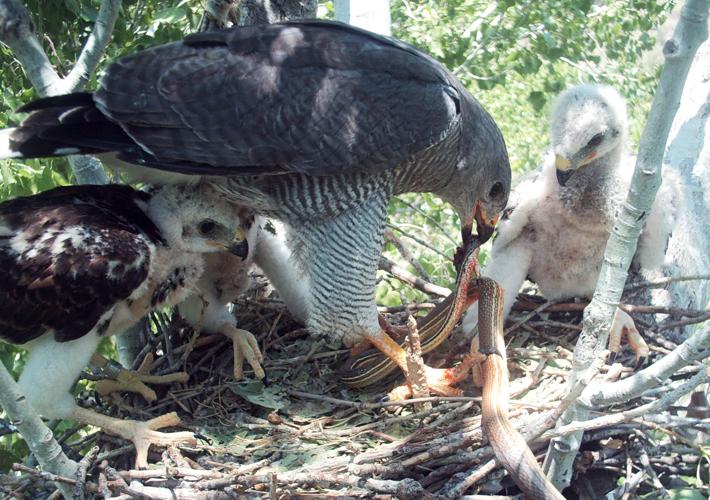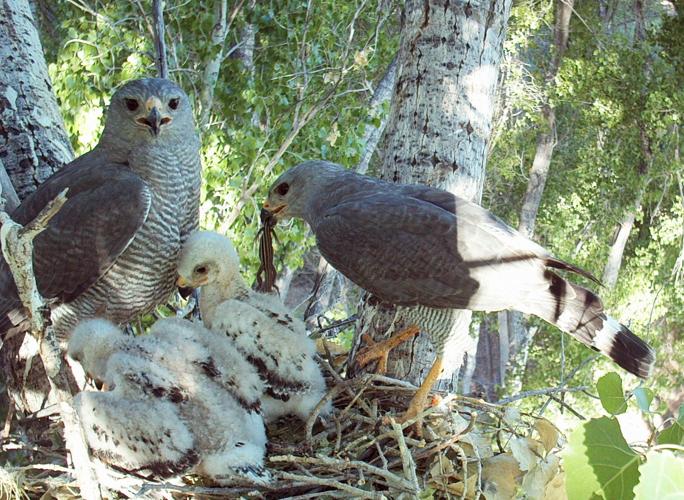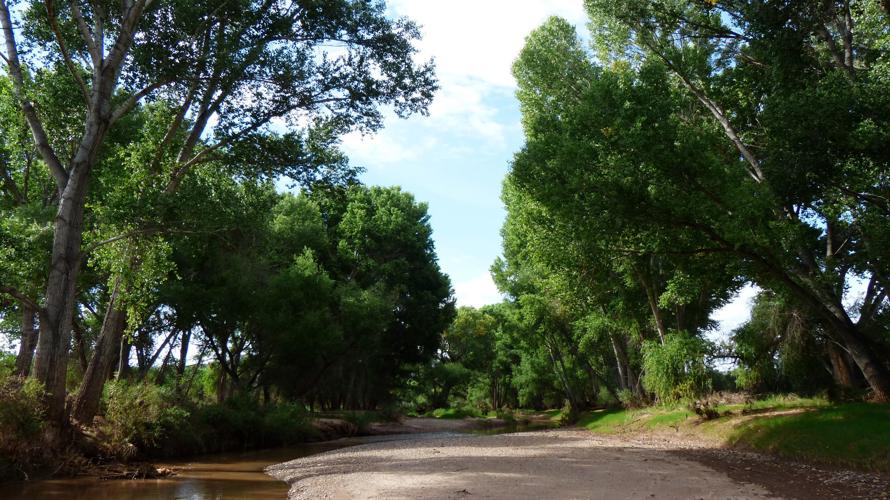The gray hawk is a prime symbol of Southern Arizona’s lush riparian areas, a bird described by Cornell Lab of Ornithology as “an elegant, rain-cloud gray raptor with neatly barred underparts” and “a striking long, black-banded tail.”
The “sophisticated-looking” bird “keeps close to cottonwoods and willows along rivers, perching in the mid to upper canopy, watching for lizards or other vertebrate prey that it catches with a quick descending attack,” Cornell says.
With its characteristic piercing yet gentle scream, the gray hawk is now a major draw for ecotourists who flock here to add to their life lists sightings of birds that live in few other parts of the United States, says the Tucson Audubon Society.
And a new study shows a rapid expansion of gray hawk nesting along the federally protected stretch of the Upper San Pedro River east of Sierra Vista, although there is disagreement among researchers as to why that might have happened.
The study’s findings amplify a broader population increase of this small hawk across Southern Arizona and points north.
Once rarely seen
A few decades ago, gray hawks were considered near-rarities in Arizona, hanging out mainly along cottonwood- and willow-dominated streams such as the San Pedro and Sonoita Creek close to the Mexican border and virtually never found farther north than the San Pedro near Winkelman.
At one time, they numbered at most 50 nesting pairs in the United States, while they were common in Mexico and in the tropics farther south, says an Audubon Society online field guide to birds.
But their populations have sprung northward into the Verde, Hassayampa and Bill Williams rivers in Arizona’s midsection.
They’ve also nested in the oak woodlands of the sky islands — as the forested mountain ranges surrounded by desert in Southern Arizona are called — including the Santa Ritas and the Huachucas.
The hawk’s U.S. population now numbers about 2,000 in Arizona, New Mexico and south Texas, with the vast majority living in Arizona, says the multiagency group known as Partners in Flight.
The newly published study on the San Pedro is the first to document any part of this increase with specifics. Written by former University of Arizona graduate student Ariana La Porte, the study found 70 gray hawk nests during surveying on and off from 2010 to 2016. Her work was supervised by now-retired University of Arizona biologist and professor Bill Mannan, who co-authored the study.
La Porte walked the river and employed remote cameras and on-the-ground surveys to track hawks, their nesting activities and their young.
In 1997, researchers on an earlier study found 44 such nests in the San Pedro Riparian National Conservation Area, so La Porte’s findings show a 59% increase since then.
One theory: Fewer cattle, more hawks
The new study theorizes that the gray hawks increased at least in part because cattle were pulled from most of the riparian conservation area right after Congress established the preserve in 1988.
That allowed more grasslands to grow and gave the hawks more access to food — in this case grassland cotton rats — that weren’t there or were in much lesser quantities before, the study says. The peer-reviewed study was published last month in the Journal of Wildlife Management.
“The elimination of grazing seems to have allowed small mammals to recover, and gray hawks are taking advantage of these resources as prey” in the San Pedro conservation area, said La Porte. “We found that gray hawks need a place to nest and a place rich in small wildlife in which to hunt.”
However, the study’s conclusions drew a rebuke from longtime Arizona raptor specialist Rich Glinski, who wrote a chapter on the gray hawk in the 1998 book “Raptors of Arizona,” which he also edited.
A former Arizona Game and Fish Department biologist and state ornithologist, the now-retired Glinski said gray hawks are “woodland birds, not grassland birds” that depend mainly on tree stands and their surrounding vegetation for shelter and prey.
For the most part, the hawk’s expansion in the San Pedro simply matches its expansions across the region, Glinski said.
“It is to be expected that gray hawks will take grassland mammals that venture close to the woods. This situation does not exist in many places where the gray hawk occurs at lower elevations in Arizona, and the grassland factor should not be given too much credit for gray hawk expansion in the state,” he said.
Grazing now a big San Pedro issue
Coincidentally, the new study appeared about a month before four environmental groups sued to try to force cattle off the only areas of the San Pedro conservation area, 7,000 or so acres, where they have been allowed to stay since 1988.
The suit challenges a U.S. Bureau of Land Management plan for the river area that also for the first time allows an unspecified amount of “targeted grazing” aimed at removing invasive species such as Johnson grass from the area.
The suit says nothing about gray hawks.
Mannan, the study’s co-author, said he had no position on the lawsuit.
But Glinski is a longtime advocate of targeted grazing in selected areas of the river. While he welcomed the removal of most cattle from the river, he wanted back in 1988 to use cattle on a small scale to remove an invasive plant known as London rocket, which he said grows very densely under mesquite after wet winters, creating more fuel for possible wildfires.
“Limited grazing would be a way to remove this and create a more open ground under mesquite that could facilitate gray hawk foraging for lizards,” he said.
Climate change could be a factor
Where Glinski and La Porte agree is that the origins of the hawk’s broader expansion are not totally clear.
La Porte says she believes climate change is likely one of several factors contributing to the expansion, since the hawks are not only being seen farther north but are known to winter in some of Southern Arizona’s sky island mountain ranges.
Since only one other published gray hawk study exists, “we still have much to learn about how this species adapts to different environmental conditions,” said La Porte, who is now a Ph.D. candidate at Monash University’s School of Biological Sciences in Australia.
Many other Mexican-based birds have been making their way more and more into Arizona recently as the weather warms, and Glinski agreed that climate change could be affecting the gray hawk.
Yet, with migratory birds like gray hawks that spend half of their life cycles in Mexico, “it’s hard to say what has changed there in the last 30 to 50 years,” he said.
Unanswered questions about climate change include “how does that influence the plant and animal distribution, how does that create conditions that gray hawks like?” said Glinski.
Historic range was broader
The gray hawk used to be much more common in parts of Southern Arizona, including long-vanished riparian areas along the Santa Cruz and Rillito rivers in Tucson back in the 1800s, before groundwater pumping for urban growth drained the underlying aquifers, said Jonathan Horst, the Tucson Audubon Society’s conservation and research director.
But they weren’t common back then on the San Pedro, which until the early 1900s was a marshy cienega of a river flowing through grasslands, Glinski said.
Since then, erosion caused in part by overgrazing “gutted the river,” causing it to become entrenched and causing cottonwood groves to move in along the riverbed, and mesquites to follow on the benches above the river, said Glinski.
A population of lizards followed, “creating a niche for the gray hawk” that previously didn’t exist, he said. The whiptail lizard was the gray hawk’s most common food source for many decades afterward and is still considered a prime part of its diet in most places.
The San Pedro conservation area was created in part to protect and improve the habitat for the hawk, recalled Glinski, who sat in on many of the discussions with federal officials who shaped the preserve’s boundaries and early management.
UA’s Mannan said La Porte’s research shows that it appears that after the cattle were gone and the grass came back, “the hawks were able to use areas that they weren’t using before, that because the grasslands recovered, they began to hunt small mammals occupying the grasslands. This is somewhat speculative. We don’t know for sure this is why this is happening. But this is based on the evidence of what they’re eating.”
The researchers, who also included Northern Arizona University graduate student Samantha Brewer, didn’t find the hawks’ nest building and productivity was related to the presence of mesquite, Mannan said.
“We found them doing well in nests surrounded by grasslands,” he said, noting that was a contrast to what the previous, 1997 gray hawk study found. “They appeared to be eating in grasslands. We’re not claiming they’re grassland birds, but when they have areas with grasslands around their nests, they’re able to make use of it.”
Glinski, however, said gray hawks have long been adapted for hunting in more closed-in woodland areas. When the San Pedro was mostly a marshy cienega around the turn of the 20th century, the river was lined by grasslands but the gray hawks weren’t there much, he said.
Today, many of the places where the hawks are now expanding, including the Buenos Aires National Wildlife Refuge in Southern Arizona, have grown brushier with thicker, denser mesquite and other tree and shrub stands, he said.
Buenos Aires used to be mostly open country that drew Swainson’s hawks, which the gray hawks are now replacing, he noted.
Many factors can affect the productivity of a top-level predator like the gray hawk, and using nesting activity and productivity in a study of this short a time “leaves room for so much error,” Glinski said.
But Tucson Audubon bird conservation biologist Jennie MacFarland said the new study’s conclusions make sense.
“Why wouldn’t they go out and use a new food source? They’re adaptable,” MacFarland said of the gray hawks.
“So many species depend not only on the core areas where they nest, they go into adjacent areas and they hunt for prey there,” she said. “If foods are nearby where the bird is nesting, they will go get it.”








